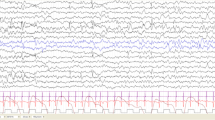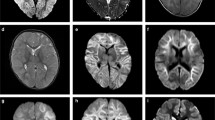Abstract
Purpose
We aimed to determine the characteristics of epileptic seizures that significantly affect the cognitive functions of 83 patients followed with tuberous sclerosis complex (TSC), their resistance to treatment and risk factors causing this resistance.
Materials-methods
In order to determine the prognosis, the seizure-free/seizure-controlled group and the group with refractory seizures were compared. In addition, risk factors affecting cognitive functions in the patients were determined.
Results
There was a statistical significance between the presence of a history of seizures in the neonatal period, the age of onset of seizures being less than 2 years of age, autism, status epilepticus, Lennox-Gastaut syndrome (LGS), presence of infantile spasm, generalization of the electroencephalography (EEG) findings, the number of tubers in cerebral imaging being more than three and refractory seizures (p < 0.05). Statistically significant relationship was found between presence of a history of seizures in the neonatal period, the age of onset of seizures, autism, LGS, presence of infantile spasm, presence of status epilepticus history, history of using more than three antiepileptic drugs, generalization of EEG findings, presence of SEGA in cerebral imaging, number of tubers being more than three and the patient’s mental retardation (p < 0.05).
Conclusion
In logistic regression analysis, the age of the seizure onset being less than 2 years of age, the presence of autism and number of tubers being more than three in cerebral magnetic resonance imaging (MRI) are determined to be the risk factors that most likely to increase the seizures to be more resistant.
Similar content being viewed by others
References
Curatolo P, Bombardieri R, Jozwiak S (2008) Tuberous sclerosis. Lancet 372:657–668
Hallett L, Foster T, Liu Z, Blieden M, Valentim J (2011) Burden of disease and unmet needs in tuberous sclerosis complex with neurological manifestations: systematic review. Curr Med Res Opin 27:1571–1583
Kwiatkowski DJ, Manning BD (2014) Molecular basis of giant cells in tuberous sclerosis complex. N Engl J Med 371:778–780
Child ND, Benarroch EE (2014) mTOR: its role in the nervous system and involvement in neurologic disease. Neurology 83:1562–1572
Yates JR, Maclean C, Higgins JN et al (2011) The tuberous sclerosis 2000 study: presentation, initial assessments and implications for diagnosis and management. Arch Dis Child 96:1020–1025
Chu-Shore CJ, Major P, Camposano S et al (2010) The natural history of epilepsy in tuberous sclerosis complex. Epilepsia 51:1236–1241
Northrup H, Krueger DA (2013) International tuberous sclerosis complex consensus group. Tuberous sclerosis complex diagnostic criteria update: recommendations of the 2012 international tuberous sclerosis complex consensus conference. Pediatr Neurol 49:243–254
Shinnar S (2010) The new ILAE classification. Epilepsia 51:715–717
Vignoli A, La Briola F, Turner K, Scornavacca G, Chiesa V, Zambrelli E et al (2013) Epilepsy in TSC: certain etiology does not mean certain prognosis. Epilepsia 54:2134–2142
Jozwiak S, Shwarz RA, Janniger CK, Bielicka-Cymerman J (2000) Usefulness of diagnostic criteria of tuberous sclerosis complex in pediatric patients. J Child Neurol 15:652–659
Sparagana SP, Delgado MR, Batchelor LL, Roach ES (2003) Seizure remission and antiepileptic drug discontinuation in children with tuberous sclerosis complex. Arch Neurol 60:1286–1289
Wang S, Fallah A (2014) Optimal management of seizures associated with tuberous sclerosis complex: current and emerging options. Neuropsychiatr Dis Treat 23:2021–2030
Shehata H, AbdelGhaffar HM, Nasreldin M, Elmazny A, Abdelalim A, Sabbah A, Shalaby N (2017) Clinical patterns and outcomes of status epilepticus in patients with tuberous sclerosis complex. Ther and Clin Risk Manag 13:779–785
Saxena A, Sampson JR (2015) Epilepsy in tuberous sclerosis: phenotypes, mechanisms, and treatments. Semin Neurol 35:269–276
Primec ZR, Stare J, Neubauer D (2006) The risk of lower mental outcome in infantile spasms increases after three weeks of hypsarrhythmia duration. Epilepsia 47:2202–2205
Camposano S, Greenberg E, Kwiatkowski D, Thiele EA (2009) Distinct clinical characteristics of tuberous sclerosis complex patients with no mutation identified. Ann Hum Genet 73:141–146
Mizuguchi M, Takashima S (2001) Neuropathology of tuberous sclerosis. Brain and Development 23:508–515
Goh S, Butler W, Thiele EA (2004) Subependymal giant cell tumors in tuberous sclerosis complex. Neurology 63:1457–1461
Chou IJ, Wong A, Wang HS, Chou ML, Hung PC, Hsieh MY, Chang MY (2008) Neuroimaging correlation with neurological severity in tuberous sclerosis complex. Eur J Paediatr Neurol 12:108–112
Soo MP, Yong JL, Yong JS, Yong OK, Yong JW (2011) Clinical progress of epilepsy in children with tuberous sclerosis: prognostic factors for seizure outcome. Chonnam Med J 47:150–154
Goodman M, Lamm SH, Engel A, Shepherd CW, Houser OW, Gomez MR (1997) Cortical tuber count: a biomarker indicating neurologic severity of tuberous sclerosis complex. J Child Neurol 12:85–90
Kopp CM, Muzykewicz DA, Staley BA et al (2008) Behavior problems in children with tuberous sclerosis complex and parental stress. Epilepsy Behav 13:505–510
Bolton PF, Park RJ, Higgins JN et al (2002) Neuroepileptic determinants of autism spectrum disorders in tuberous sclerosis complex. Brain 125:1247–1255
Bolton PF, Griffiths PD (1997) Association of tuberous sclerosis of temporal lobes with autism and atypical autism. Lancet 349:392–395
Walz NC, Byars AW, Egelhoff JC, Franz DN (2002) Supratentorial tuber location and autism in tuberous sclerosis complex. J Child Neurol 17:830–832
Author information
Authors and Affiliations
Corresponding author
Ethics declarations
On June 1, 2018, under the decree no 72, ethic committee approval of the study from Cukurova University Faculty of Medicine Non-Interventional Clinical Trials Ethics Committee and consent from the families of the patients to participate in the study were obtained
Conflict of interest
The authors declare that they have no conflict of interest.
Additional information
Publisher’s Note
Springer Nature remains neutral with regard to jurisdictional claims in published maps and institutional affiliations.
Rights and permissions
About this article
Cite this article
Gül Mert, G., Altunbaşak, Ş., Hergüner, Ö. et al. Factors affecting epilepsy prognosis in patients with tuberous sclerosis. Childs Nerv Syst 35, 463–468 (2019). https://doi.org/10.1007/s00381-019-04066-7
Received:
Accepted:
Published:
Issue Date:
DOI: https://doi.org/10.1007/s00381-019-04066-7




